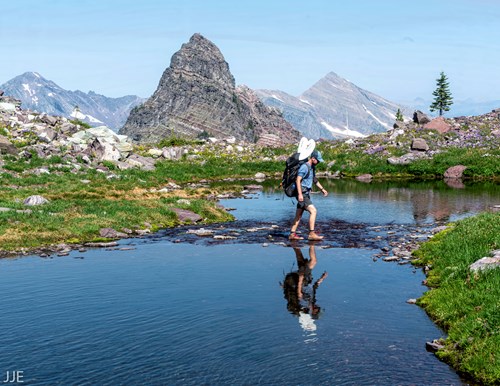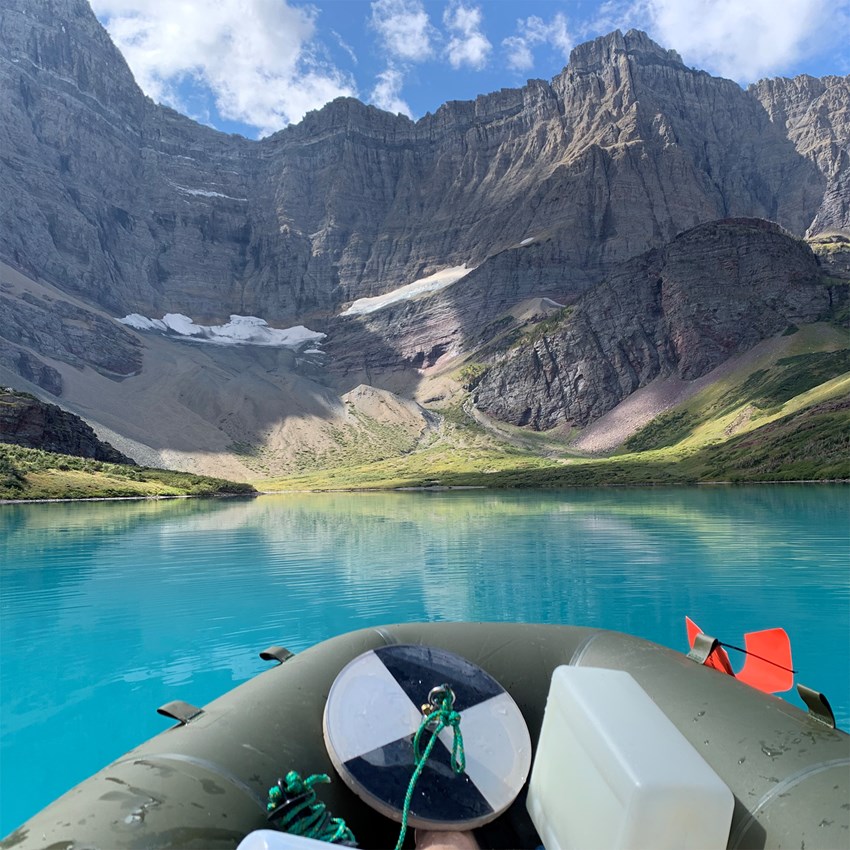UM Bio Station Scientists Say Glacier Loss Will Bring Significant Changes to Alpine Lakes in the Northern Rocky Mountains
Nearly half of the world’s population can trace its water supply to mountainous regions, where ice and snow have regulated water quantity and quality for generations. But as mountain glaciers continue to rapidly retreat due to climate change, we are currently transitioning to a world in which our mountains may no longer sustain permanent snow and ice.
With climate warming in the high-elevation mountains of North America occurring two to three times faster than the global average—a trend that is predicted to accelerate over the coming decades—the potential impacts to our mountain freshwater ecosystems are becoming of increasingly greater economic and environmental concern.
In a study recently published by the scientific journal Limnology and Oceanography, Flathead Lake Biological Station (FLBS) graduate student Joe Vanderwall and a team of FLBS researchers studied alpine lakes in Montana’s Northern Rocky Mountains and Glacier National Park in order to investigate what the loss of our glaciers, glacial lakes, and the unique habitats they provide might mean for the biogeochemical and ecological characteristics of our mountain ecosystems and the human services they provide.
“This project was really sparked by wanting to understand what’s happening in these lakes as they form,” Vanderwall said in a recent interview with the Flathead Beacon. “This represents the blink of an eye in geologic time, and we don’t want to miss out on the opportunity to document their formation. And to do that, we’re really just posing some basic biology questions. What is living there? What are the primary producers? What is the base of the food web? How much biomass is there and what are the rates of photosynthesis?”
As glaciers recede, they can leave behind newly formed lakes born from glacial meltwater. But in high alpine elevations, there are also lakes fed only by snowpack meltwater. While the two types of lakes may look similar on the surface, scientists haven’t previously plunged into the depths of their respective characteristics to better understand the differences between them.
To help address this gap in understanding, Vanderwall and his fellow researchers surveyed alpine lakes fed by glacial meltwaters and compared the nutrient concentrations, chemistry, water clarity, chlorophyll, and zooplankton communities to lakes at similar elevations that were fed by snowpack alone.

FLBS graduate student Joe Vanderwall hikes into the high elevations of Glacier National Park to find answers in the new lakes forming from glacial loss.
The researchers found that in glacial lakes phosphorus and nitrate concentrations were three times higher compared to non-glacial lakes. Phosphorus and nitrogen are nutrients that play a fundamental role in the cultivation of life, and higher phosphorus and nitrogen concentrations typically mean there is a greater potential for algal growth, microorganisms, and other aquatic life.
However, the scientists discovered that the organic carbon concentrations (produced by living organisms) of these glacially-fed lakes were actually two times lower than in non-glacial lakes. Additionally, the carbon-to-phosphorus ratio and the nitrogen-to-phosphorus ratio of lake seston (the particles suspended in a body of water) increased with water clarity in glacial lakes.
This suggests that in glacial lakes, fine-grained, silt-sized particles of rock generated through mechanical grinding of bedrock by glacial erosion—known as glacial flour—increase light limitation and decrease food quality for zooplankton (the small invertebrate animals that live in our freshwaters).
“We saw a pretty large difference between snowpack-fed lakes and glacially fed lakes, which have higher concentrations of phosphorous and nitrogen,” Vanderwall said. “We recorded over two times the amount of phosphorous and nitrogen in glacial lakes. The hypothesis for why glaciers are shedding a lot of nitrogen and phosphorous is pretty obvious, in that there is a lot of nitrogen deposited into the lakes from the atmosphere, from fossil fuel burning deposited from rain or snow. Snowpack has that, too, but glaciers condense that over centuries.”
Scientists also found that while concentrations of chlorophyll (the photosynthetic pigment in algae) did not appear to differ between lake types, the zooplankton communities were notably different. In glacier lakes, the zooplankton communities were largely comprised of cyclopoid copepods and rotifers, which are known as non-filter feeders. In non-glacial lakes, the communities were dominated by calanoid copepods and cladocerans, which are filter feeders.
Filter feeding is a method some organisms use to feed by extracting small pieces of food and other particles while moving through the water or taking advantage of water moving by them. High levels of fine sediments such as glacial flour decrease the effectiveness of filter-feeding.
As warming trends continue, the loss of mountain glaciers will also bring the loss of glacial lakes and the unique conditions they provide. At current rates, all alpine glaciers are predicted to completely disappear from the Northern Rocky Mountains by 2100, which means that we can expect significant changes to nutrient dynamics, biogeochemical processes, and biodiversity of lakes across this heterogenous mountain region.
“The lakes forming in this iconic place are ultimately at the top of our water tower flowing into the whole Columbia River basin, and at the park’s hydrological apex it’s also flowing into the Hudson Basin,” Vanderwall said. “So preserving the water quality and observing what’s happening in these top systems that are changing so rapidly is critical to preserving these resources for future generations, and if we can’t preserve them then at least we can monitor them in the future.”
Moving forward, scientists say that more work is needed to understand how the physical and biogeochemical characteristics of alpine lakes are affected by climate-induced glacier loss in high-elevation landscapes, so that we can best prepare for a freshwater future in which our legendary mountains of majesty no longer sustain their caps of snow and ice.
Additional authors on the study include FLBS associate research professor and USGS aquatic ecologist Clint Muhlfeld, FLBS research scientist Tyler Tappenbeck, FLBS research scientist Joe Giersch, Nanjing Institute of Geography and Limnology scientist Ze Ren, and FLBS director Jim Elser.
For the complete study, visit the Association for the Sciences of Limnology and Oceanography’s Limnology and Oceanography website at https://aslopubs.onlinelibrary.wiley.com/doi/10.1002/lno.12434


